This post may contain Amazon affiliate links which means, as an Amazon Associate, I may receive a small commission from purchases made through these links at no cost to you. I only recommend products I have personally used. To learn more, please see my privacy policy page.
Halloween, originating from Celtic Samhain, marks the boundary between the living and the dead. Now global, it embraces diverse traditions, from Dia de los Muertos in Mexico to Obon in Japan, illustrating the universal human fascination with the mystical and the departed.
Key Words
- dia de los muertos
- guy fawkes
- jack-o’-lantern
- obon
- samhain
Discover how Halloween’s ancient origins and global evolution have shaped traditions. Dive deeper into the history, cultures, and eerie celebrations that make this holiday a fascinating crossroads of the world’s spookiest traditions. Read on…
Let's Explore Halloween!
Halloween: a single word that conjures images of eerie decorations, creative costumes, and the thrill of the unknown. It’s a holiday that has captured the imagination of people around the world, transcending borders and cultures. Each year, on the last day of October, millions of individuals of all ages gather to revel in the enchanting aura that surrounds this unique celebration.
At its heart, Halloween is a time-honored tradition that has evolved over centuries, drawing from a variety of cultures and histories. It’s a day when the ordinary transforms into the extraordinary, where the boundaries between the living and the spirit world blur, and where the past, future, and present seamlessly intertwine. This kaleidoscope of traditions and narratives from various corners of the globe makes Halloween more than just a holiday – it’s a global phenomenon that unites us in our fascination with the mysterious and the macabre.
As the Autumn leaves fall and a crisp chill fills the air, the world readies itself for Halloween’s spellbinding embrace. From the bustling neighborhoods of the United States to the colorful streets of Mexico and the tranquil landscapes of Japan, the traditions associated with this bewitching holiday vary as much as the cultures that hold them dear. In the sections that follow, we’ll embark on a journey through time and across continents, exploring the richness of Halloween traditions that have woven themselves into the fabric of our world.
But before we dive into these captivating cultural rituals, it’s essential to understand the roots from which Halloween springs. Like the twisting vines of a haunted forest, the history of Halloween winds its way through the annals of time, drawing from ancient customs and centuries-old beliefs. So, let’s step back in time and explore the origins of Halloween, shedding light on the Celtic festival of Samhain, the Christian influences that gave rise to All Saints’ Day and All Souls’ Day, and the fusion that birthed the modern Halloween we know today.
From there, we’ll traverse continents and oceans to discover the vibrant mosaic of traditions that color the global Halloween experience. From the vibrant celebrations of Mexico’s Dia de los Muertos, where families gather to remember and honor their departed loved ones, to the subdued and reflective lantern-lit dances of Japan’s Obon Festival, where ancestral spirits are welcomed back to the realm of the living, we’ll uncover the unique ghost stories that shape Halloween around the world.
So, dear reader, fasten your seatbelts – or rather, your capes, costumes, and masks – as we embark on a journey through the mystical realms of Halloween. As the moon rises and the stars twinkle overhead, I invite you to join me in unraveling the enigma of this spellbinding holiday, one tradition at a time.
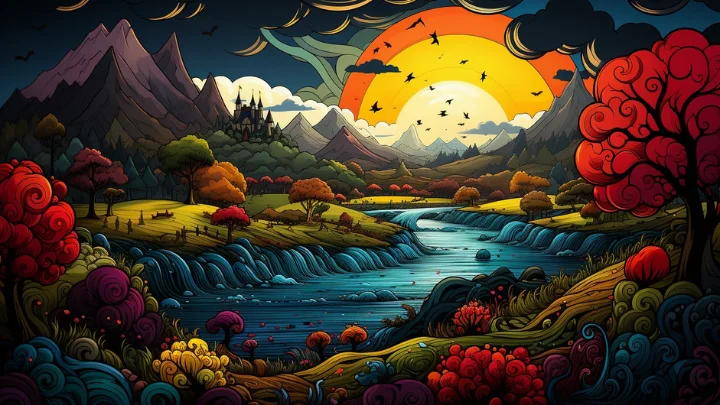
Historical Origins of Halloween
In the midst of the crisp fall air and the rustling leaves, the origins of Halloween lie buried beneath the layers of time. To understand the enchanting past of this holiday, we must venture back to the ancient Celtic lands and the festival of Samhain (pronounced sah-win).
Samhain, celebrated around November 1st, marked the close of the harvest season and the commencement of the colder, darker days of winter. For the Celts, this transitional period held profound significance. They believed that on the eve of October 31st, the boundary separating the world of the living from the realm of the deceased became remarkably porous. As the sun dipped below the horizon, the barrier between these two worlds dissolved, allowing spirits, both good and bad, to traverse freely between them.
The Celts donned costumes made from animal hides and sacred plants, seeking to both honor and ward off these visiting spirits. Bonfires blazed in homage to the Celtic deities and to provide a guiding light for those traversing the murky veil between the realms. As the night wore on, communities gathered to feast and revel, their laughter and camaraderie acting as a protective shield against the potentially sinister intentions of the visiting spirits.
With the passage of time and the march of history, the Celtic traditions intertwined with the Christian beliefs that arrived on the shores of the British Isles. The Christian observances of All Saints’ Day on November the 1st and All Souls’ Day on November 2nd held resemblances to Samhain’s reverence for the departed. As the church sought to ease the transition from pagan rituals to Christian observances, these holy days merged with the Celtic festival, resulting in a hybrid celebration that retained elements of both worlds.
This merging of cultures gave rise to the modern Halloween. The name “Halloween” itself is derived from “All Hallows’ Eve,” referring to the night before All Saints’ Day. It’s a time when the past and the present collide, and the ethereal and the tangible momentarily converge. The costumes that were once donned to mimic and repel evil spirits have now become an embodiment of fantasy and imagination. The bonfires that once guided evil spirits now light up the night in a dazzling display of carved pumpkins, transforming them into iconic jack-o’-lanterns.
As we move forward in our exploration of Halloween’s global reach, we’re reminded that the holiday’s roots are deeply embedded in the ancient soil of the past. The spirits of Samhain continue to dance in the flickering flames of our jack-o’-lanterns, and the boundary between worlds remains as permeable as it was in the days of old. With this historical foundation in place, let’s set our course for the far reaches of the globe, where the spirits of Halloween manifest in diverse and wondrous ways.

Halloween in the United States
From the colonial cobblestone streets to the sprawling suburbs of today, Halloween in the United States has undergone a fascinating metamorphosis, shaping itself into the kaleidoscopic celebration we know today.
Evolution of Halloween
The early roots of American Halloween trace back to the colonial era when European immigrants, including the Irish and Scottish, brought with them their cherished customs. These traditions intermingled with the already established practices of Native American communities, resulting in a unique fusion of cultures. Over the years, as the U.S. grew and evolved, Halloween evolved as well, adapting to the changing social and cultural landscape.
The Birth of the Jack-O'-Lantern
At the heart of American Halloween is the tradition of carving pumpkins into whimsical and eerie jack-o’-lanterns. This practice finds its origins in the ancient Irish legend of “Stingy Jack.” As the story goes, Jack tricked the Devil and managed to escape both heaven and hell, leaving him to wander in the darkness with only a carved-out turnip holding a coal to light his way. When Irish immigrants arrived in the United States, they found that pumpkins, native to the region, were an ideal substitute for turnips, giving birth to the iconic American jack-o’-lantern.
Irish and Scottish Influences
The prevalence of trick-or-treating in the United States can be attributed, in part, to the Irish and Scottish immigrants who brought with them the practice of “souling” and “guising.” In Ireland, “souling” involved going door-to-door to collect “soul cakes” in exchange for prayers for the deceased. Similarly, in Scotland, “guisers” would dress up in costumes and perform songs or tricks in exchange for food. These customs gradually blended with the American Halloween culture, transforming into the trick-or-treating tradition we cherish.
Trick-or-Treating Takes Center Stage
Perhaps one of the most cherished Halloween traditions in the United States is the age-old practice of trick-or-treating. The ritual of going door-to-door, dressed in costumes, and receiving treats has a history that harkens back to medieval times. In the early 20th century, Halloween was marked by community gatherings, where games and pranks were common. However, the Great Depression and World War II led to a shift in the holiday’s focus. To mitigate vandalism and promote a more communal spirit, communities began organizing safe and supervised trick-or-treating events. This practice gained momentum, becoming the beloved tradition we know today.
As the United States embraced Halloween, it also introduced its unique spin on the holiday. From elaborate haunted houses and costume parties to festive parades and community gatherings, Halloween in the U.S. is an extravaganza that celebrates the spirit of imagination, community, and creativity. As we journey further into our exploration of Halloween around the world, remember that every carved pumpkin, every piece of candy, and every playful prank pays homage to a rich history and culture.

Dia de los Muertos (Day of the Dead) in Mexico
Amid the vibrant whirlwind of marigold petals and candy skulls and the melodious strumming of guitars, Mexico brings forth its own enchanting twist on the Halloween season with the celebration known as Dia de los Muertos or the Day of the Dead.
Embracing Life and Death
Celebrated on November 1st and 2nd, Dia de los Muertos is a time when death is not feared, but rather embraced and celebrated as an integral part of life’s grand venture. This unique holiday is a fusion of indigenous Aztec rituals and Catholic influences, creating a harmonious blend that honors departed loved ones with both solemnity and exuberance.
Colors and Memories
One cannot help but be captivated by the kaleidoscope of colors that grace Dia de los Muertos celebrations. Marigolds, also known as “cempasúchil,” blanket the streets, cemeteries, and ofrendas, infusing the air with their golden brilliance and a distinctive scent believed to guide the spirits back to the world of the living. Elaborate sugar skulls, intricately designed and adorned with vibrant hues, pay homage to the souls of the departed, their eye sockets gazing upon the living with a sense of whimsy and connection.
Ofrendas: Creating a Welcoming Altar
At the heart of Dia de los Muertos are the ofrendas, altars lovingly assembled in homes and cemeteries to welcome and honor the spirits of the departed. These ofrendas are a tangible bridge between the worlds, a place where memories, stories, and emotions converge. Each ofrenda is a unique creation, reflecting the personality and preferences of the departed soul. These altars are adorned with cherished mementos, photographs, candles, incense, and the favorite foods and drinks of those who have passed. It’s believed that these offerings serve as a way to sustain and nourish the spirits during their brief return to the realm of the living.
A Feast for the Senses
Dia de los Muertos is a sensory feast that extends beyond the visual. Families gather in cemeteries to clean and decorate the graves of their loved ones. They share meals, recount stories, and even play lively music, creating an atmosphere of celebration amongst the mourning. Pan de Muerto, a sweet bread adorned with bone-shaped decorations, is a staple of the holiday, symbolizing the cycle of life and death.
A Celebration of Connection
Dia de los Muertos is a celebration that reminds us of the interconnectedness of generations and the enduring bond between the living and the departed. It’s a time when grief is embraced and mixed with remembrance. As long as we remember the ones we’ve lost, death is seen as a continuation rather than an end. This Mexican tradition illustrates that life’s journey is incomplete without acknowledging and honoring those who came before us, and that death is merely a step in the dance of existence.
As we continue our global journey through the diverse landscape of Halloween traditions, the celebration of Dia de los Muertos serves as a poignant reminder that the beauty of life lies not only in its moments of light but also in the shadows that give it depth and meaning.
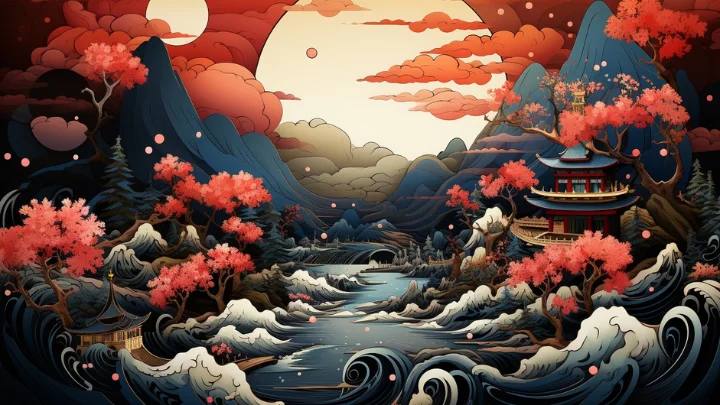
Obon Festival in Japan
In the land of cherry blossoms and ancient traditions, Japan’s Obon Festival emerges as a poignant celebration that bridges the realms of the living and the departed. While it may take place in the heat of the summer, the Obon Festival shares a similar essence with Halloween – a commemoration of ancestors and a dance with the ephemeral nature of existence.
Honoring Ancestral Spirits
Held typically in July or August, the Obon Festival is rooted in Buddhist and Shinto beliefs and commemorates the spirits of one’s ancestors. During this time, it’s believed that the spirits return to the realm of the living to visit their families. Just as the autumn leaves begin to fall and the veil between worlds thins, lanterns are lit, and dances are performed to welcome the spirits back home.
Guiding the Way with Lanterns
One of the most captivating aspects of the Obon Festival is the sight of countless paper lanterns gently illuminating the streets and riverbanks. These lanterns, known as “toro nagashi,” symbolize the journey of the spirits from the world of the living back to the spiritual realm. Each lantern carries a heartfelt message and a silent prayer, guiding the ancestors on their fleeting return.
The Dance of Remembrance
Central to the Obon Festival is the traditional “Bon Odori” dance. As the sun dips beneath the horizon, communities gather in open spaces to perform these dances, clad in colorful yukata (summer kimono). The Bon Odori reflects a sense of unity and reverence, as participants move in elegant patterns to the rhythm of drums and traditional music. Through these dances, the living express their gratitude to their forebears, creating a beautiful cycle of remembrance and connection.
Fleeting Moments and Eternal Bonds
In the heart of Obon, there’s an acknowledgment of life’s impermanence – a recognition that the bonds we share with our ancestors transcend the boundaries of life and death. As lanterns sway in the breeze and dancers twirl under the night sky, the Obon Festival encapsulates the profound Japanese concept of “mono no aware” – the beauty of transience. It’s a reminder that while life is fleeting, the impact of our presence and the memories we leave behind echo through time.
As we look further into the kaleidoscope of global Halloween traditions, the Obon Festival beckons us to honor our ancestors in a way that is uniquely Japanese – a delicate dance between honoring the past, celebrating the present, and embracing the future.
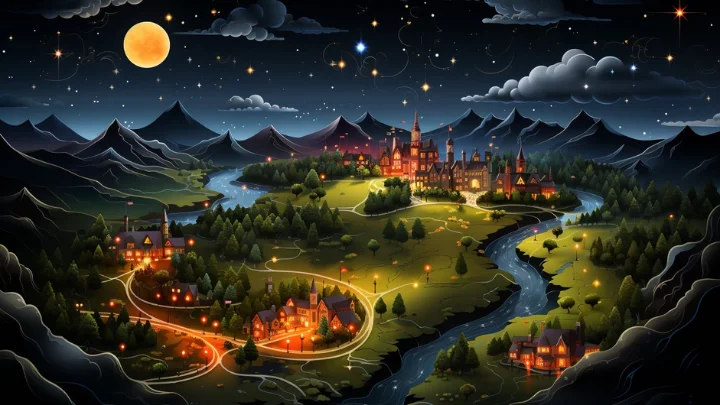
Guy Fawkes Night in the United Kingdom
Amidst the foggy autumn evenings of the United Kingdom, a different kind of fire lights up the night sky on November 5th – it’s Guy Fawkes Night, a spirited commemoration that fuses history, tradition, and the fascinating dance of flames and sparks.
The Historical Spark
The origins of Guy Fawkes Night can be traced back to the 1605 Gunpowder Plot, a dramatic and daring conspiracy that aimed to overthrow the Protestant monarchy by blowing up the Houses of Parliament. Guided by a passionate desire for religious freedom, a group of Catholic conspirators, including Guy Fawkes, plotted to ignite a stockpile of gunpowder hidden beneath the parliamentary chambers. However, the plot was foiled just hours before its execution, and Guy Fawkes was captured, ultimately leading to his execution. The thwarting of the plot gave rise to a tradition of celebration, as the Protestant monarchy and Parliament survived the threat.
Bonfires and Fireworks Illuminate the Night
Guy Fawkes Night, also known as Bonfire Night, revolves around the idea of remembering the failed plot in a rather explosive manner. As dusk falls, bonfires are kindled, casting an eerie glow reminiscent of the historical turmoil. The night sky is adorned with dazzling fireworks that crackle and burst, evoking the sound of gunpowder conspiracies long past. The atmosphere is charged with both excitement and historical remembrance, as families and communities gather to witness the brilliant spectacle.
Burning Effigies and Cultural Resonance
A distinctive feature of Guy Fawkes Night is the creation and burning of effigies, often in the form of “Guys” – figures representing Guy Fawkes himself. These effigies are paraded through the streets before being placed atop the bonfires, symbolizing the victory of the Protestant monarchy over the Catholic conspirators. Beyond the historical symbolism, the event carries a unique cultural significance. It’s a time when the British people unite to celebrate their resilience and the preservation of their institutions.
A Multifaceted Celebration
Guy Fawkes Night is a celebration that embodies both remembrance and revelry. It’s a nod to the past and a reminder of the fragility of power and the importance of safeguarding one’s values. The fiery displays evoke a sense of awe, not only for the pyrotechnics themselves but also for the endurance of history’s lessons. As fireworks burst like stars and effigies crackle in the flames, Guy Fawkes Night stands as a testament to the British spirit of triumph over adversity, resonating through the centuries.
In our exploration of Halloween traditions across the world, Guy Fawkes Night invites us to reflect on how history, culture, and celebration mix to create a captivating spectacle that echoes the heartbeat of a nation.
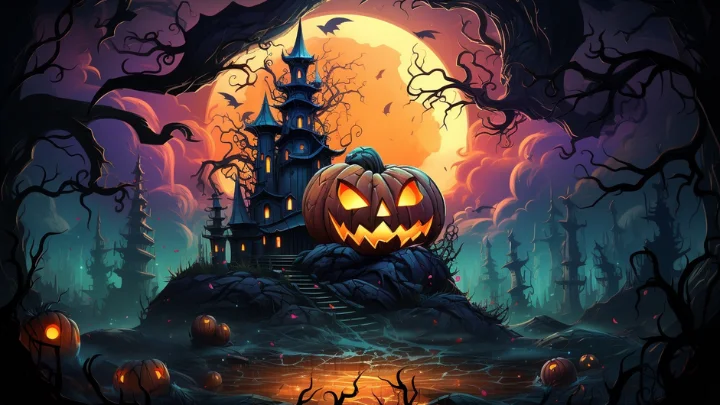
Halloween's Global Popularity
From the heart of ancient Celtic lands to the bustling streets of modern metropolises, Halloween’s flickering flame has spread its enchantment far beyond its origins, evolving into a global celebration that unites people of diverse cultures and backgrounds.
A World Embraced by the Spooky Spirit
What was once a niche holiday celebrated in a handful of regions has now become a phenomenon that transcends borders. The allure of Halloween, with its fusion of mystery, creativity, and communal celebration, has captivated the imaginations of young people across the globe. This embrace of the spooky spirit has led to an international tapestry of traditions, each uniquely adapted to fit local customs and beliefs.
Halloween Around the World
Countries such as Canada, Australia, and numerous European nations have embraced Halloween with open arms, each infusing the holiday with their own distinct flair. In Canada, the streets come alive with costumed children trick-or-treating door-to-door, while in Australia, where Halloween coincides with the Southern Hemisphere’s spring, people take to outdoor gatherings and parties. In various European countries, from the UK to Germany, Halloween’s influence can be seen in decorations adorning homes, parties, and local festivities.
The Commercial Carnival
Halloween’s journey from local observance to global phenomenon has been significantly propelled by its commercialization. The once-humble holiday, rooted in ancient traditions, has morphed into a consumer-driven carnival of costumes, decorations, and treats. From elaborate haunted attractions to themed merchandise that lines store shelves, Halloween’s commercial side has opened the door to its widespread adoption. While some purists may lament the shift towards consumerism, it’s also a testament to the holiday’s adaptability and enduring appeal.
A Universal Yearning for the Enchanted and Mysterious
Halloween’s remarkable global popularity speaks to a universal human yearning for the enchanted and mysterious. Whether it’s the joy of creative expression through costumes, the thrill of spooky decorations, or the sense of community fostered by neighborhood trick-or-treating, Halloween’s appeal resonates across cultures. It taps into our shared fascination with the unknown and allows us to momentarily step into a realm where fantasy and reality intertwine.
In a world marked by diverse traditions and perspectives, Halloween stands as a unifying force, demonstrating that even with variations in customs and beliefs, there are aspects of human experience that transcend borders. As we watch the glowing jack-o’-lanterns and listen to the rustling of costumes, we’re reminded that Halloween’s journey from past to present, from local to global, is a testament to the enduring power of tradition, imagination, and the thrill of the spooky and supernatural.
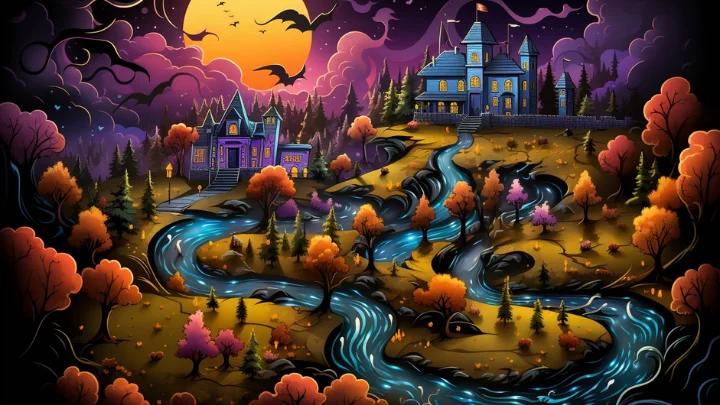
Cultural Appropriation and Sensitivity
As Halloween’s popularity continues to grow on a global scale, it’s important to remember that the celebration of diverse traditions comes with a responsibility to be respectful and culturally sensitive. While it’s natural to be drawn to the intriguing and captivating customs from around the world, it’s crucial to approach them with a deep sense of appreciation and understanding.
Honoring and Respecting Traditions
When engaging with Halloween traditions from different cultures, it’s essential to approach them with a genuine desire to honor and respect their origins. These traditions often carry deep historical, religious, or familial significance. Using elements from another culture in a frivolous or disrespectful manner can perpetuate harmful stereotypes and strip away the meaningful context that these practices hold.
Appreciation vs. Appropriation
Appreciating and learning from diverse Halloween traditions is an enriching experience that can foster cultural understanding and empathy. However, it’s vital to draw a clear line between appreciation and appropriation. Appreciation involves genuinely engaging with the meaning behind a tradition, recognizing its importance, and learning from it in a respectful way. Appropriation, on the other hand, involves borrowing elements for personal enjoyment without regard for their cultural significance, often leading to misrepresentation and harm.
Research and Education
Before incorporating elements of a different culture’s Halloween tradition into your own celebrations, take the time to research and understand the context and history behind it. Learn about the significance of specific symbols, practices, and rituals. This knowledge will not only enrich your understanding of the tradition but also help you avoid misunderstandings and offensive behavior.
Fostering Cultural Exchange
Cultural sensitivity goes hand in hand with fostering genuine cultural exchange. If you’re intrigued by a particular Halloween tradition from another culture, consider engaging in educational experiences that allow for mutual learning. Attend workshops, read books, or connect with individuals who can provide authentic insights. Engaging in respectful dialogue and seeking permission from members of the culture in question can help bridge the gap between curiosity and respectful engagement.
Embracing the Spirit of Unity
Ultimately, Halloween is a time when people come together to celebrate imagination, creativity, and the unknown. By approaching the traditions of other cultures with respect and sensitivity, we can further enrich the global tapestry of this holiday. The beauty of Halloween lies not only in its diverse practices but also in its potential to unite us as we collectively embrace the magic of shared celebrations.
In the spirit of unity and understanding, let us approach Halloween traditions from around the world with an open heart and a commitment to honoring the cultures that inspire them. Through this approach, we can create a more inclusive and meaningful celebration for everyone involved.
Wrap Up...
As we draw closed the curtain on our journey through the captivating world of Halloween traditions, we find ourselves surrounded by rich history, culture, and the ethereal. From the ancient Celtic festival of Samhain to the vibrant festivities of Dia de los Muertos in Mexico, from the lantern-lit dances of Japan’s Obon Festival to the crackling bonfires of Guy Fawkes Night in the United Kingdom, we’ve explored a spectrum of celebrations that span continents and eras.
Amidst the diverse practices and rituals, a common thread emerges – the profound significance of remembering the departed and embracing the enigmatic. Regardless of the culture or tradition, the concept of honoring ancestors and confronting the mysteries of life and death is a universal theme that binds us as humans.
Halloween, in all its global variations, stands as a testament to the enduring power of human imagination and the human need to connect with something beyond the ordinary. It’s a holiday that doesn’t just revel in the spooky and supernatural, but also invites us to pause and reflect on the deeper questions of existence.
As we reflect on the luminous lanterns, the crackling bonfires, the swirling dances, wear costumes and the laughter of trick-or-treaters, we’re reminded that Halloween is more than just a day on the calendar. It’s a celebration that encapsulates our collective fascination with the mysterious, our innate desire to honor those who came before us, and our boundless capacity for creativity.
Halloween’s rich history, global reach, and myriad interpretations make it a holiday that is, at its core, inclusive. It’s a reminder that in a world marked by differences, there are aspects of our shared humanity that unite us – our fascination with the unknown, our love for celebration, and our yearning to weave stories that bridge generations.


